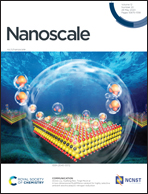Gradient phosphorus-doping engineering and superficial amorphous reconstruction in NiFe2O4 nanoarrays to enhance the oxygen evolution electrocatalysis†
Abstract
A better solid–liquid–gas three-phase boundary is vital for low energy cost oxygen evolution reaction (OER), making the designed regulation of interfacial atmosphere necessary. Herein, we find that the OER electrocatalysis can be dramatically improved by synergistically forming disordered electronic structures and superficial amorphous layers, as superficial oxyhydroxide, phosphorus-doped NiFe2O4 nanoarrays on nitrogen-doped carbon nanofibers (OP-NiFe2O4/NCNFs). Unveiled by the depth-profiling analysis from the X-ray photoelectron spectroscopy, the contents of phosphorous doping in the OP-NiFe2O4 nanoarrays change dynamically from outside to inside due to its in situ superficial reconstruction into the oxyhydroxide layer, thereby accelerating electron transfer between heterogeneous phases. As revealed by density functional theory calculations, this amorphous oxyhydroxide layer and dynamically varied phosphorous content would positively shift the d-band center of the NiFe2O4-related compounds, leading to lower adsorption energy towards water molecule. Thus, the OP-NiFe2O4/NCNF electrocatalyst displays a low overpotential of 260 mV at a current density of 10 mA cm−2 and a small Tafel slope of 44.8 mV dec−1 in an alkaline medium.



 Please wait while we load your content...
Please wait while we load your content...